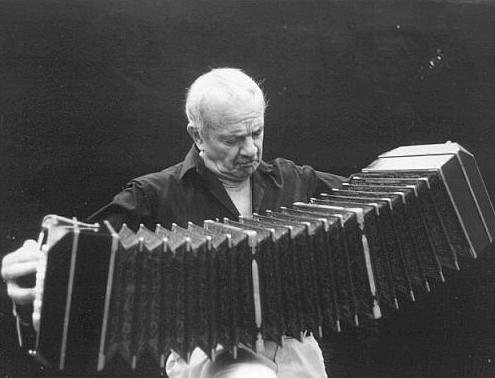Astor Piazzolla, March 11, 1921 – July 4, 1991 was an Argentine tango composer. He was also a bandoneon player. His work transformed the traditional tango into a nuevo style, which incorporated elements from jazz and classical music. He was a great bandoneonist and performed his own compositions regularly with various ensembles. In his homeland, he is called “El Gran Astor”, or “The Great Astor”. Piazzolla was born in Argentina to Italian immigrants in 1921. He spent his childhood in New York City with his family. He learned four languages while living in New York City: Spanish, English and French. He began playing the bandoneon and quickly rose to the rank of child prodigy. He met Carlos Gardel while still young. In 1937, he returned to Argentina, where traditional tango was still the dominant form of dance, and he played in nightclubs with several groups. Arthur Rubinstein, a pianist who was living in Buenos Aires at the time, advised him to study with Alberto Ginastera, an Argentine composer. He began to study scores by Stravinsky, Bartok and Ravel. After this, he quit tango and became a modernist classical composer. Ginastera encouraged Piazzolla to enter his “Buenos Aires Symphony” in a composition contest in 1953. He won a grant from France to study with Nadia Boulanger, a French composer and conductor. Piazzolla recounts how the insightful Boulanger changed his life in just a few days. When she began to read them, she suddenly said, “It’s very well-written.” She then stopped with a large period and rounded like a soccer ball. After a while she said, “Here, you’re like Stravinsky. Like Bartok. Like Ravel. But you know what happens?” She said, “I can’t find Piazzolla here.” And she started to probe my private life. What I did, what and where I didn’t play. If I was single, married or living with someone, she was almost like an FBI agent. It was very embarrassing for me to admit that I was a tango performer. I finally said “I play at a night club.” She didn’t want me to say “cabaret.” I thought it was funny to tell her that. She kept asking me: “You don’t claim to be a pianist?” She kept asking me: “What instrument are you playing, then?” I hesitated to admit that I was a pianist, but she finally asked me to play some bars from a tango. She suddenly opened her eyes and took my hand. “That’s Piazzolla!” I took all my music, ten years worth, and sent it to hell in just two seconds. Piazzolla, who returned to Argentina in 1955 to perform tangos, founded the Octeto Buenos Aires. His new approach to the tango, called nuevo tango, made him a controversial figure in Argentina. He said that “in Argentina everything can change — except for the tango”, which is a reference to some of the resistance he encountered in Argentina. His music was accepted in Europe and North America and his reworking the tango was embraced in Argentina by liberal sections of society. They were also pushing for political change in tandem with his musical revolution. Piazzolla was a resident of Italy during the Argentine military dictatorship, 1976-1983. He returned to Argentina many times, recorded there and had lunch with Jorge Rafael Videla at least once. His relationship with the dictator was not always friendly. This is reflected in Astor Piazzolla: A manera de Memorias, a collection of interviews that tells how he died in Buenos Aires in 1990 after a thrombosis in Paris. Piazzolla’s nuevo Tango was different from traditional tango because it included elements of jazz, extended harmonies, dissonance, counterpoint and used extended compositional forms. Piazzolla introduced new instruments to the traditional tango. These included the flute, saxophone and electric guitar as well as a complete jazz/rock drum set. Piazzolla was a member of many ensembles, including the 1946 Orchestra, the 1955 Octeto Buenos Aires, the 1960 “First Quintet”, 1971 “Noneto”, 1978 “Second Quintet,” and 1989 “Sextet”. He was also the director and Bandoneon player for all of them, as well as creating original arrangements and compositions. He recorded an album with Yo-Yo Ma, a jazz sax player, and another with Gerry Mulligan. Many of his compositions include orchestral pieces such as the “Concierto para Bandoneon, Orquesta, Cuerdas y Percusion”, the “Doble-Concierto para Bandoneon y Guitarra”, the “Tres Tangos Sinfonicos”, and the “Concierto de Nacar para 9 Tanguistas y Orquesta”. He also recorded song-form compositions, including “Balada para un loco”, (dedicated) and “Adios Noninos Noninos Noninos Noninos Noninos Noninos Noninos Nonino) that he had many different musicians and bands and recordings. According to biographers, Piazzolla recorded approximately 500 pieces and wrote about 3,000 more. Text contributed by users is available under Creative Commons By–SA License. It may also be available under GNU FDL.
